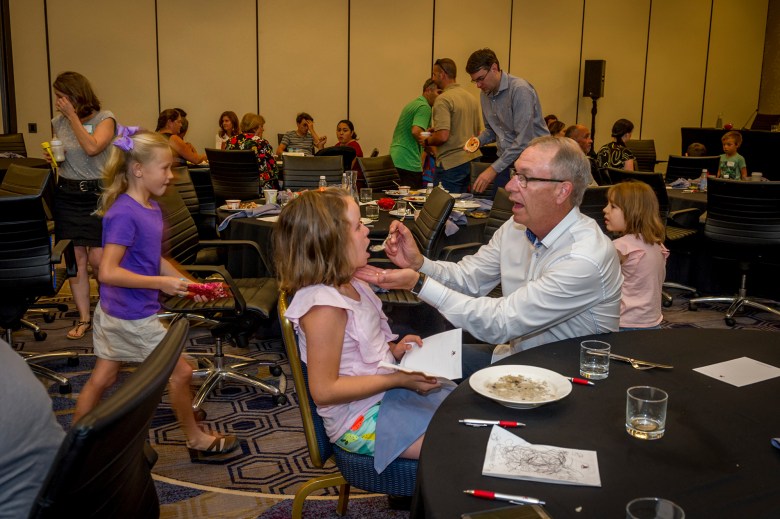In summary
Joe Lang has helped shape California policy as a lobbyist since the 1980s. For the past decade, he’s pushed to find a cure for his daughter’s ultra-rare genetic disorder.
California lobbyist Joe Lang wakes up early every morning, checks his email and begins what he calls his second job — helping coordinate a nationwide medical research program into the extremely rare genetic disorder that affects his daughter.
It’s not the kind of task he imagined for himself over his long career in Sacramento, and yet he’s been a driving force to find a treatment for the neurodevelopmental disorder that is named after his daughter, Jordan. He helped assemble the research team when his family learned Jordan was just one of a handful of children diagnosed with the syndrome, and he’s been raising money for the work ever since.
“If somebody said, ‘We want to help your child,’ as a dad you’re going to say, ‘Ok, what do I need to do?’” he said.
That dad’s work achieved a major milestone this month when Japanese drugmaker Shionogi announced it is beginning a clinical trial into a treatment for Jordan’s Syndrome, a condition that is marked by developmental delays and a range of symptoms that make it difficult to impossible for people to take care of themselves.
Jordan, 10 years old when she was diagnosed, is now 19.
The company credited Lang and his family’s foundation, Jordan’s Guardian’s Angels, when it announced the trial. “Shionogi is honored to partner with Jordan’s Guardian Angels on this historic study as we work together to advance our shared commitment to helping patients and families affected by Jordan’s Syndrome,” said the company’s chief medical officer, Juan Carlos Gomez.
The state of California played an important role in that progress, too. It allocated a total of $33 million in the 2018 and 2021 state budgets to fund early research into Jordan’s Syndrome, money that enabled doctors at 10 universities and hospitals to collaborate on their work rather than compete against each other for federal grants.
That investment is expected to help lower consumer costs of a treatment, Lang said, if a drug gains approval from the Food and Drug Administration.
It’s unusual for the California Legislature to fund research into a specific rare disease, although it has earmarked money to build the MIND Institute at UC Davis that researches developmental disorders, and it funded breast cancer research with a 1993 cigarette tax.
Former Sen. Richard Pan, the Sacramento Democrat who helped secure the state funding for Jordan’s Syndrome, said lawmakers were persuaded to put money into the research because of its potential to shed light on other genetic disorders.
“This has always been the challenge of when you have conditions that just affect a handful of kids,” said Pan, a pediatrician. “By understanding what’s happening with these kids, you understand what’s happening with a larger group as well.”
For instance, people diagnosed with Jordan’s Syndrome tend to share some symptoms that resemble autism or Parkinson’s disease. Getting a better understanding of the specific gene malfunction that results in Jordan’s Syndrome could help researchers gain insight into those conditions.
“Even though it’s a rare disease, it has a lot of implications for cancer and Parkinsons,” said Jan Nolta, the director of the stem cell program at UC Davis. Her team is among the contributors to the research into Jordan’s Syndrome.
“So what we’re finding has ramifications for bigger things,” she said.

Lang has been working in the Capitol since the 1970s, and his firm, Lang, Hansen, Giroux and Kidane, regularly is among the top-billing lobbying organizations in Sacramento.
He and his wife, Cynthia, spent years trying to understand the cause of their daughter’s developmental delays, but could not get a diagnosis. A doctor as a last resort recommended they have Jordan’s genes mapped, which led to the discovery of a mutation on a single gene, called PPP2R5D.
At the time, just six children had been diagnosed with the condition. Now, the number is up to about 350.
Lang has been involved in the effort to find a treatment and a cure since then.
“I’m just a dad that got thrown in the deep end of the pool,” he said. “It is extremely fulfilling, but sometimes I have to be very workmanlike; this is our next job, let’s do this, let’s do that.”
The research team began its work by modeling the malfunctioning gene that causes the condition and closely studying how it malfunctioned. Then, doctors began screening tens of thousands of existing drugs to see if one could help treat the condition.
That led them to a drug called zatolmilast, which was under evaluation as a treatment for a condition that causes inherited intellectual disabilities. The drug was created by a company later acquired by Shionogi. Tests on mice indicated it could help people with Jordan’s Syndrome.
For the upcoming clinical trial, people with Jordan’s Syndrome will take a twice-daily dose of the medicine over six months. Doctors will test whether the drug improves their cognitive abilities.

Lang hopes to one day hear Jordan speak.
“If at the end of the day, with this treatment, if we can get Jordan speaking, that’s a sea change,” he said. “Once we can get speech, so many things will follow.”
The broader research team continues to investigate other potential treatments, as well as a cure.
Pan, the former state lawmaker, cautioned that the trial might not prove the treatment will work.
But, he said, “it shows that our investment is coming to some fruition. There’s no guarantee that when you invest in research that something comes out of it, and we’re not quite there yet, but the promise is good and I really appreciate Joe Lang’s leadership and his passion. That leadership is going to help a lot of kids, a lot more than people think.”
Source link



